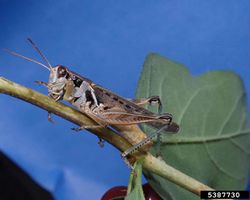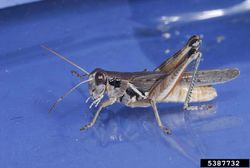Difference between revisions of "Melanoplus sanguinipes"
| (7 intermediate revisions by the same user not shown) | |||
| Line 1: | Line 1: | ||
| − | {{ | + | {{TaxLinks|LnkMelanoplus}} |
| − | {{ | + | {{LiteratureDBX|{{PAGENAME}}|653|browse,Ccountrylnk,Pcrops,AbenefialsN}} |
[[File:Melanoplus_sanguinipes_IPM5387730.jpg|250px|thumb|''Melanoplus sanguinipes'' (click on image to enlarge it)<br/>Author(s): Joseph Berger<br/>Source: [http://www.ipmimages.org/browse/detail.cfm?imgnum=5387730 IPM Images]]] | [[File:Melanoplus_sanguinipes_IPM5387730.jpg|250px|thumb|''Melanoplus sanguinipes'' (click on image to enlarge it)<br/>Author(s): Joseph Berger<br/>Source: [http://www.ipmimages.org/browse/detail.cfm?imgnum=5387730 IPM Images]]] | ||
| − | <font color="#800000">'''''Melanoplus sanguinipes'''''</font> (Fabricius) - devastating grasshopper | + | <font color="#800000">'''''Melanoplus sanguinipes'''''</font> (Fabricius, 1798) - (devastating grasshopper) |
| − | + | ||
| + | This is one of the most damaging grasshopper species in western North America. It lives mainly in grasslands, but attacks various crops, like small grains, alfalfa or canola. Outbreaks where grasshoppers reach high densities and adults form swarms have been reported periodically. Eggs are laid in the soil during autumn and hatch the following spring when rains start. The 6 nymphal stages are completed within 6 weeks to 2 months. In warmer regions there may be 2 generations per year. The adults are up to 5 cm long. The structure of the male genitalia is diagnostic for distinguishing it from closely related species. | ||
| + | [[File:Melanoplus_sanguinipes_IPM5387732.jpg|250px|thumb|left|''Melanoplus sanguinipes'' (click on image to enlarge it)<br/>Author(s): Joseph Berger<br/>Source: [http://www.ipmimages.org/browse/detail.cfm?imgnum=5387732 IPM Images]]] | ||
| + | [[Category:Melanoplus (genus)]] | ||
'''Synonyms:'''<br/> | '''Synonyms:'''<br/> | ||
''Melanoplus affinis''<br/> | ''Melanoplus affinis''<br/> | ||
| Line 11: | Line 13: | ||
''Melanoplus devastator''<br/> | ''Melanoplus devastator''<br/> | ||
''Melanoplus mexicanus'' | ''Melanoplus mexicanus'' | ||
| − | |||
{{VN | {{VN | ||
|en=devastating grasshopper<br/>lesser migratory grasshopper | |en=devastating grasshopper<br/>lesser migratory grasshopper | ||
|fr=criquet voyageur | |fr=criquet voyageur | ||
}} | }} | ||
| − | |||
| − | |||
| − | |||
| − | |||
| − | |||
| − | |||
Latest revision as of 17:39, 10 April 2022
| Literature database |
|---|
| 275 articles sorted by: |
| • year (descending) |
| • research topics |
| • countries/regions |
| • host plants |
| • list of natural enemies |
Melanoplus sanguinipes (Fabricius, 1798) - (devastating grasshopper)
This is one of the most damaging grasshopper species in western North America. It lives mainly in grasslands, but attacks various crops, like small grains, alfalfa or canola. Outbreaks where grasshoppers reach high densities and adults form swarms have been reported periodically. Eggs are laid in the soil during autumn and hatch the following spring when rains start. The 6 nymphal stages are completed within 6 weeks to 2 months. In warmer regions there may be 2 generations per year. The adults are up to 5 cm long. The structure of the male genitalia is diagnostic for distinguishing it from closely related species.
Synonyms:
Melanoplus affinis
Melanoplus atlanis
Melanoplus bilituratus
Melanoplus devastator
Melanoplus mexicanus
| Vernacular names | |
|---|---|
| • English: | devastating grasshopper lesser migratory grasshopper |
| • Français: | criquet voyageur |

